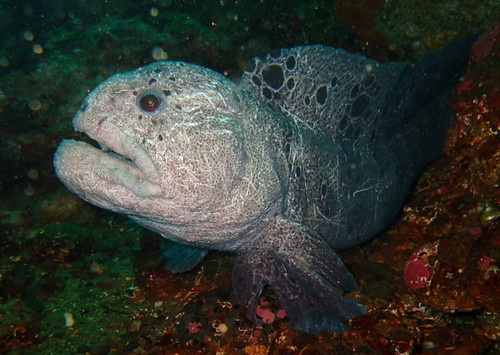
Wolf Eel
The Atlantic bluefin tuna (Thunnus thynnus) is a highly migratory, large predatory fish renowned for its size, speed, and commercial value. This species plays a crucial role in the marine ecosystem and has significant economic importance.
10 25 years
Lifespan
240 cm
Length
Least Concern
Conservation Status
null km/h
Swimming speed
Carnivorous
Diet
Sedentary
Migration
Appearance Overview
The Atlantic bluefin tuna has a robust, streamlined body built for speed and endurance.
Coloration
Dark metallic blue above and silvery-white below
Fins
Two dorsal fins, the first depressible into a groove; small finlets behind second dorsal and anal fins
Body Shape
Torpedo-shaped, with a conical snout and a crescent-shaped tail
Length
Up to 13 feet (4 meters), commonly around 6.5 feet (2 meters)
Weight
Up to 2,000 lbs (900 kg), commonly around 550 lbs (250 kg)
Diet
Carnivorous, feeding on a variety of fish, squid, crustaceans, and occasionally zooplankton and echinoderms.
Feeding Behavior
Opportunistic predators, they use their speed and agility to hunt. They often feed cooperatively, herding prey into tight balls before striking.
Social Behavior
Highly migratory, forming large schools, especially during spawning. Schools may segregate by size.
Commercial Relevance
Extremely high value, especially in sushi and sashimi markets, where a single fish can fetch tens or even hundreds of thousands of dollars.
Conservation measures
Subject to international fishing quotas and regulations, marine protected areas, and efforts to reduce bycatch. Research and monitoring programs are ongoing.
Status
Endangered (Varies by population segment; some are considered critically endangered)
Threats
Overfishing (historically and ongoing in some areas), bycatch in other fisheries, climate change affecting prey distribution and spawning grounds, and habitat degradation.
Habitat Distribution
Depth Range
0-1,000 meters (0-3,280 feet), but most commonly found in the upper few hundred meters
Geographic Range
North Atlantic Ocean, Mediterranean Sea, and formerly in the Black Sea
Preferred Environment
Temperate and subtropical waters; open ocean (pelagic) and coastal areas
Reproduction and Life Cycle
Breeding Habits
Spawns in warm waters, with two main spawning grounds: the Mediterranean Sea and the Gulf of Mexico. Spawning occurs in large aggregations.
Development Stages
Eggs are pelagic and hatch into larvae. Larvae are planktonic and develop rapidly, undergoing several morphological changes before reaching the juvenile stage. Growth continues throughout their life.
Fecundity
Highly fecund; a large female can produce up to 30 million eggs per spawning season.
Maturity Age
Reaches sexual maturity at around 4-8 years, depending on the population and environmental conditions.
Faqs about Wolf Eel
Where are Atlantic bluefin tuna found?
Atlantic bluefin tuna are found across the North Atlantic Ocean, including the Mediterranean Sea.
Do Atlantic bluefin tuna migrate?
Yes, they are highly migratory, traveling thousands of miles across the ocean to reach feeding and spawning grounds.
How fast can Atlantic bluefin tuna swim?
They are among the fastest fish in the ocean, capable of reaching speeds over 40 mph (64 km/h) in short bursts.
How long do Atlantic bluefin tuna live?
Atlantic bluefin tuna can live for up to 40 years, although this is rare due to fishing pressure.
What is the biggest threat to Atlantic bluefin tuna?
The main threat is overfishing, primarily driven by the high demand for their meat in the sushi market.
Are Atlantic bluefin tuna warm-blooded?
They have a unique physiology that allows them to maintain a body temperature higher than the surrounding water, aiding in their speed and endurance.
Copyright @ Nature Style Limited. All Rights Reserved.
 English
English